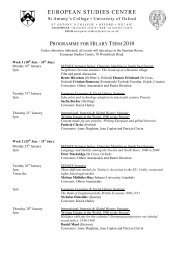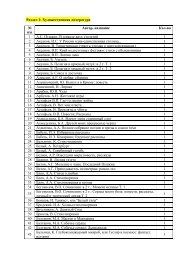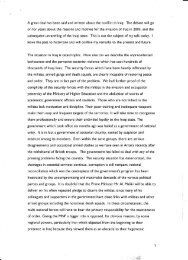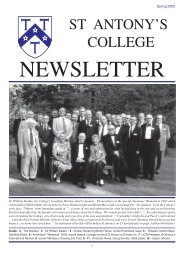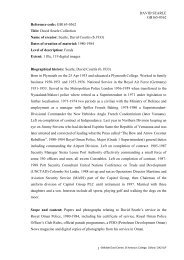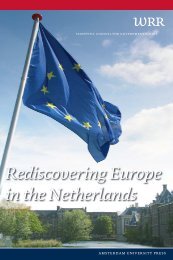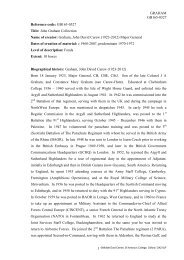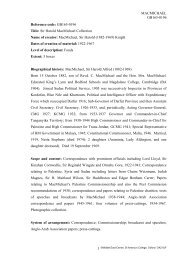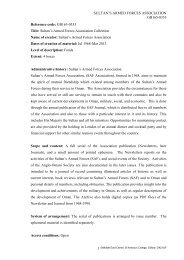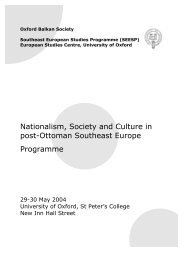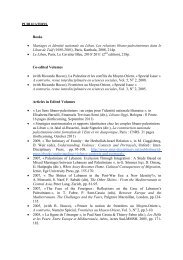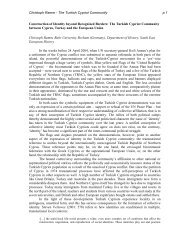Managing Migration: The Global Challenge, Population Bulletin, Vol ...
Managing Migration: The Global Challenge, Population Bulletin, Vol ...
Managing Migration: The Global Challenge, Population Bulletin, Vol ...
You also want an ePaper? Increase the reach of your titles
YUMPU automatically turns print PDFs into web optimized ePapers that Google loves.
<strong>Managing</strong> <strong>Migration</strong>: <strong>The</strong> <strong>Global</strong> <strong>Challenge</strong><br />
reasons may be moving to escape unemployment or<br />
persecution, or supply-push factors.<br />
A worker in rural Mexico may decide to migrate to the<br />
United States because a friend or relative tells him of a<br />
job. In this case, the availability of higher wage jobs is a<br />
demand-pull factor. <strong>The</strong> same worker may not have a regular<br />
job at home or may face debts from a family member’s<br />
medical emergency, and these supply-push factors<br />
also encourage emigration. For this worker, a network of<br />
friends and relatives already played a role by providing<br />
information on jobs and wages in the United States. This<br />
network and others pave the way at many points during<br />
the migration process. Networks encompass everything<br />
from moneylenders who provide the funds needed to pay<br />
a smuggler for help crossing the border to employers or<br />
friends and relatives at the destination who help migrants<br />
find jobs and places to live.<br />
Demand-pull, supply-push, and network factors rarely<br />
exert equal pressure in an individual migration decision,<br />
and their importance can change over time. Generally,<br />
demand-pull and supply-push factors are strongest at<br />
the beginning of a migration flow, and network factors<br />
become more important as a migration stream matures.<br />
<strong>The</strong> first migrant workers are often recruited, beginning<br />
the migration flow. In the 1940s, for instance, the U.S.<br />
government sent recruiters to rural Mexico to fill jobs on<br />
U.S. farms. Migrants returned with savings, encouraging<br />
more people to seek U.S. jobs and fueling unauthorized<br />
migration. After this migration stream had been established,<br />
network factors ranging from settled friends and<br />
relatives to the expectation that men, particularly young<br />
ones, should “go north for opportunity” sustained migration<br />
between rural Mexico and rural America after the<br />
Mexico-U.S. Bracero program ended in 1964. A similar<br />
process played out in Western Europe: After governments<br />
stopped recruiting Turks and other southern European<br />
workers from 1973 to 1974, more arrived to unify families<br />
or to seek asylum.<br />
One of the most important noneconomic motivations for<br />
crossing national borders is family unification. In such cases,<br />
the immigrant in the destination country is a demand-pull<br />
factor for family migration. Spouses and children join the<br />
immigrant first and may be followed by parents and brothers<br />
and sisters, in so-called chain migration.<br />
<strong>Global</strong>ization has made people everywhere aware of<br />
conditions and opportunities abroad. Tourism has become<br />
a major industry, as people cross national borders to<br />
experience new cultures, different weather, or the wonders<br />
of nature. Many young people find a period of foreign<br />
study or work experience enriching. In some cases,<br />
former colonies have become independent nations, but<br />
traditional migration patterns persist, with a continuing<br />
flow from India and Pakistan to the United Kingdom and<br />
from the Philippines to the United States.<br />
Immigration policies aim to facilitate wanted migration,<br />
such as tourism, and to deter unwanted migrants, including<br />
those who arrive on tourist visas and do not depart as<br />
scheduled. However, it is often hard for inspectors at ports<br />
of entry to distinguish between, for instance, a legitimate<br />
tourist and a potential unauthorized worker. Most countries<br />
require visas from foreigners wishing to enter and<br />
maintain consulates abroad to screen potential visitors to<br />
determine if they are truly tourists or students who intend<br />
to return home. At many U.S. consulates around the<br />
world, most applicants for tourist visas are rejected.<br />
Effects of <strong>Global</strong>ization<br />
<strong>Global</strong>ization has increased links between countries, as<br />
evidenced by sharply rising flows of goods and capital<br />
over national borders and the growth of international and<br />
regional bodies that regulate such movements. However,<br />
controlling the entry and stay of people is a core element of<br />
national sovereignty, and flows of people are not governed<br />
by a comprehensive global migration regime. Most nationstates<br />
do not welcome newcomers as immigrants, but almost<br />
all of the industrialized or high-income countries have guest<br />
worker programs that allow local employers to recruit and<br />
employ foreign workers. <strong>The</strong>se countries also attract significant<br />
numbers of unauthorized or irregular migrant workers.<br />
Most of the world’s people are in developing countries,<br />
as is most population growth. <strong>The</strong> world’s population,<br />
which reached 6 billion in October 1999, is growing by<br />
1.3 percent or 80 million a year, with 97 percent of the<br />
growth in developing countries. In the past, significant<br />
demographic differences between areas prompted largescale<br />
migration. For example, Europe had 21 percent of<br />
the world’s almost 1 billion residents in 1800 and the<br />
Americas had 4 percent. When there were five Europeans<br />
for every American, millions of Europeans emigrated to<br />
North and South America in search of economic opportunity<br />
as well as religious and political freedom.<br />
Will history repeat itself? Africa and Europe have<br />
roughly equal populations today, but by 2050, Africa<br />
is projected to have three times more residents (see<br />
Figure 2). If Africa remains poorer than Europe, the two<br />
continents’ diverging demographic trajectories may propel<br />
young people from overcrowded cities such as Cairo<br />
and Lagos to move to Berlin and Rome.<br />
Two types of economic differences encourage international<br />
migration. <strong>The</strong> first is inequality between countries<br />
and the second inequality within a country. <strong>The</strong> world’s<br />
almost 200 nation-states have per capita incomes that<br />
range from less than $250 per person per year to more<br />
<strong>Population</strong> <strong>Bulletin</strong> <strong>Vol</strong>. 63, No. 1 2008 www.prb.org 5



